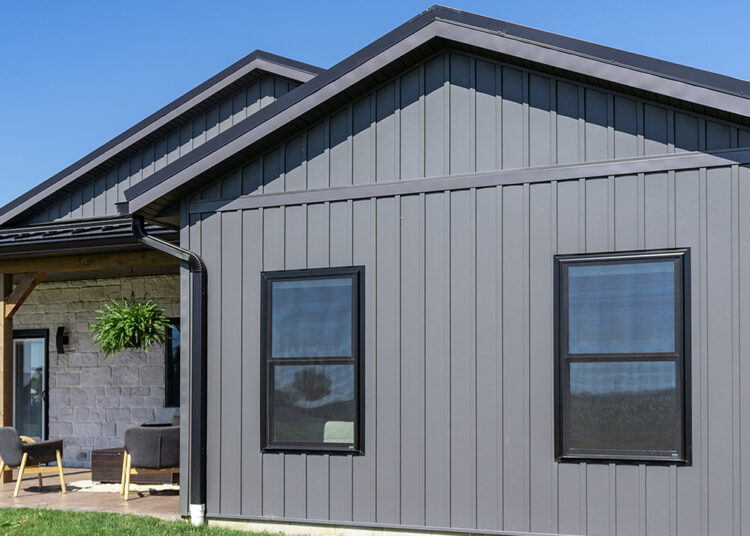Embark on a journey to transform your home with the installation of new siding. Discover how this upgrade can elevate your property's aesthetics, improve energy efficiency, and boost its overall value.
Explore the different types of siding materials available and learn about the preparation and installation process to make informed decisions for your home.
. Proper alignment, fastening techniques, and handling obstacles like windows, doors, and architectural features are crucial for a successful installation.
Benefits of Installing New Siding
Installing new siding on a house comes with a multitude of benefits that can significantly enhance the overall quality and value of your home. Replacing old siding with new siding can greatly improve the energy efficiency of your home. New siding materials are designed to better insulate your house, reducing heat loss in the winter and keeping your home cooler in the summer. This can lead to lower energy bills and a more comfortable living environment throughout the year.Reduced Maintenance Costs
Old siding can become worn out, cracked, or damaged over time, requiring frequent repairs and maintenance. By installing new siding, you can reduce the need for constant upkeep and repairs, saving you time and money in the long run. New siding materials are more durable and resistant to the elements, ensuring a longer lifespan with minimal maintenance required.Enhanced Curb Appeal and Home Value
The exterior of your home plays a crucial role in its overall appearance and curb appeal. New siding can instantly refresh the look of your house, giving it a modern and attractive aesthetic. This can significantly boost the curb appeal of your home, making it more appealing to potential buyers in the future. Additionally, new siding can increase the value of your home, providing a higher return on investment should you decide to sell.Types of Siding Materials
When it comes to choosing siding for your home, there are several materials to consider. Each type of siding material has its own unique characteristics in terms of durability, cost, maintenance requirements, aesthetics, and insulation properties.Vinyl Siding
Vinyl siding is a popular choice for homeowners due to its affordability and low maintenance requirements. It is durable, resistant to rot, and comes in a wide range of colors and styles. While it may not offer the same level of insulation as other materials, it is a cost-effective option for many homeowners.Wood Siding
Wood siding is known for its natural beauty and timeless appeal. It offers excellent insulation properties and can be painted or stained in various colors. However, wood siding requires regular maintenance, including painting, staining, and sealing to protect it from the elements and prevent rot.Fiber Cement Siding
Fiber cement siding is a durable and low-maintenance option that mimics the look of wood siding. It is resistant to rot, fire, and pests, making it a long-lasting choice for homeowners. While it may have a higher upfront cost compared to vinyl siding, fiber cement siding typically requires less maintenance over time.Metal Siding
Metal siding, such as aluminum or steel, is known for its durability and strength. It is resistant to fire, rot, and pests, making it a low-maintenance option for homeowners. Metal siding can also be painted in various colors to match your home's aesthetic. However, metal siding may not offer the same level of insulation as other materials.Preparation for Siding Installation
Before installing new siding on your house, it is crucial to properly prepare the surface to ensure a successful and long-lasting result.Inspecting Existing Siding
Prior to installing new siding, it is important to thoroughly inspect the existing siding for any signs of damage or wear. Look for cracks, rot, mold, or any other issues that may need to be addressed before proceeding with the installation.Addressing Repairs
- Repair any damaged or rotted areas in the existing siding to prevent further issues.
- Replace any missing or loose pieces of siding to ensure a uniform and secure surface for the new siding.
- Seal any gaps or cracks in the existing siding to prevent water infiltration and potential damage.
Cleaning the Surface
Before installing new siding, it is essential to clean the surface of the house to remove dirt, debris, and any mildew or mold that may have accumulated over time. A clean surface will ensure proper adhesion of the new siding and a more polished finish.Tools and Equipment Needed
- Siding removal tool or pry bar to carefully remove the old siding without damaging the underlying structure.
- Siding cleaner or pressure washer to thoroughly clean the surface of the house before installing new siding.
- Caulk and sealant to fill in any gaps or cracks in the existing siding for a seamless finish.
- Hammers, nails, and other basic tools for making repairs and securing the new siding in place.
Siding Installation Process
Installing new siding on a house involves a step-by-step process that requires attention to detail and precisionProper Siding Alignment
- Begin by measuring and marking the starting point for the siding, ensuring a level line is established.
- Overlap each siding panel correctly to prevent gaps and ensure a seamless appearance.
- Use a level frequently to check the alignment of the siding as you progress along the wall.
- Make adjustments as needed to maintain a straight and uniform look throughout the installation.
Fastening Techniques
- Use the appropriate nails or screws recommended by the siding manufacturer to secure the panels in place.
- Place fasteners at the designated intervals along the siding panels to ensure proper attachment.
- Avoid overdriving or underdriving the fasteners to prevent damage to the siding material.
- Check the manufacturer's guidelines for specific instructions on fastening techniques for the chosen siding material.
Corner Installations
- When installing siding around corners, cut the panels at the appropriate angles to create a seamless transition.
- Use corner pieces or trim to cover the exposed edges and provide a finished look to the corners.
- Ensure that the corners are properly sealed to prevent moisture infiltration and maintain the integrity of the siding.
- Check the alignment of the corners regularly to maintain a consistent appearance throughout the installation.
Handling Obstacles
- For windows and doors, carefully measure and cut the siding panels to fit around the openings accurately.
- Use flashing and sealing materials around windows and doors to protect against water intrusion and ensure a tight seal.
- When dealing with architectural features like vents or pipes, cut the siding to accommodate these elements without compromising the integrity of the installation.
- Take extra care to seal around obstacles to prevent drafts and maintain the energy efficiency of the house.
Maintenance and Care for New Siding
Proper maintenance and care are essential to ensure the longevity and appearance of your newly installed siding. By following best practices, you can keep your siding looking great for years to come.Cleaning Different Types of Siding Materials
It's important to clean your siding regularly to remove dirt, grime, and other debris that can build up over time. Here are some tips for cleaning different types of siding materials:- Vinyl Siding: Use a mixture of water and mild detergent to clean vinyl siding. Avoid using harsh chemicals or abrasive cleaners.
- Wood Siding: Clean wood siding with a mixture of water and mild soap. Be sure to rinse thoroughly and avoid using high-pressure washers that can damage the wood.
- Fiber Cement Siding: Use a soft brush or cloth with a mixture of water and mild detergent to clean fiber cement siding. Avoid abrasive scrubbing that can scratch the surface.
- Aluminum Siding: Clean aluminum siding with a solution of water and vinegar. Rinse thoroughly to prevent streaking.









